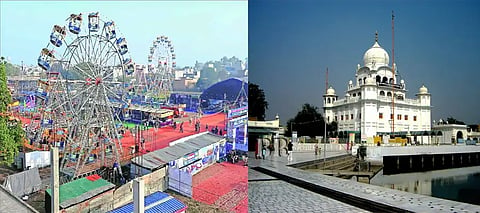

The annual three-day Maghi fair, commenced with fervor at Sri Muktar Sahib, Punjab, to honor the heroic sacrifice of the 40 muktas (liberated ones). This historic event is deeply rooted in the story of the “Batte of Khindhar, which earned the region its name. “Muktsar,” meaning the “lake of Liberation.”
Khidrana Dhab, also known as Isharsar, was a semi-desert region with a lake near the modern-day city of Sri Muktsar Sahib in Punjab India. Centuries ago, the region, of Khindrana’s Dhab, was named after Khidrana, one of the three Khatri brothers who established villages to combat water scarcity in the area. This dhab (water reservoir) became a key site during a pivotal moment in Sikh history.
After Guru Gobind Singh Ji and his followers left Anandpur Sahib, they faced barbaric Mughal armies. At Khindrana’s Dhab, the Guru set up camp and prepared for battle. Here, the 40 Sikhs, who had previously renounced their allegiance to the Guru (through the infamous “Bedawa”), returned under the leadership of ‘Mai Bhago’. Inspired by her courage and spiritual conviction, these Sikhs chose to fight for their Guru once again.
In the fierce battle that ensued, the 40 Mukhtas (sikh warriors) fought valiantly against overwhelming Mughal forces, sacrificing their lives to protect Guru Gobind Singh Ji.
After the enemy retreated, the Guru found one of the warriors, Bhai Maha Singh, gravely wounded but still alive. On his dying request, Guru Ji tore the Bedawa document, symbolically granting them forgiveness and spiritual liberation (Mukti).
This art of bravery and redemption transformed Khindrana’s Dhab into Mukstar, commemorating the sacrifice of the 40 Muktas.
The town of Muktsar, is now home to several Gurudwaras, each making key moments from the battle and its aftermath.
The Maghi Fair in Mukstar Punjab, is not just a remembrance of the past but also a vibrant celebration of Sikh traditions and culture. Devotees from across the world gather to pay homage to these Gurudwaras, take dips in the holy Sarovar, and participate in prayers and langar (community meals).
The fair also features cultural performances, martial arts, and stalls showcasing Punjabi heritage. For the faithful, this is a time of reflection, inspiration, and connection to the enduring legacy of courage and sacrifice.
As the Maghi Fair unfolds, Mukstar once again becomes a beacon of History and spirituality, reminding the world of the extraordinary bravery of the 40 Muktas and the timeless teachings of Guru Gobind Singh Ji.